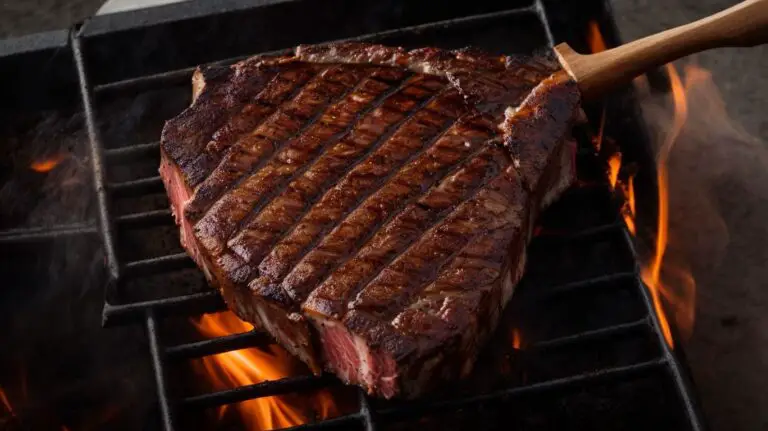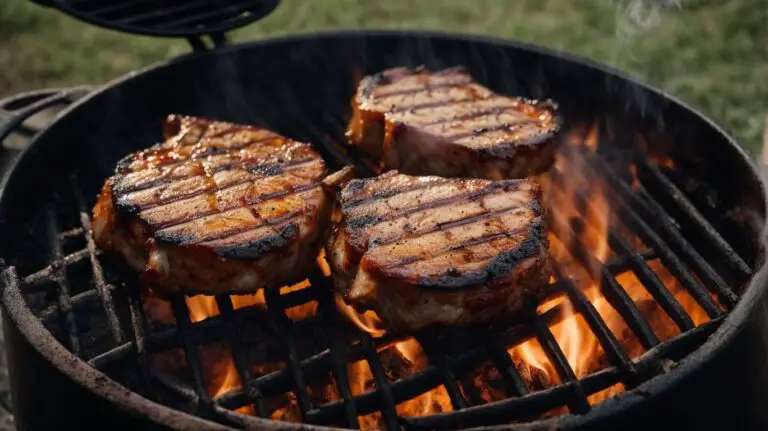How to Cook Jollof Rice Without Parboiling?
Are you a fan of Jollof Rice but tired of the traditional parboiling method?
We discuss the origins of Jollof Rice, the benefits of cooking it without parboiling, and my personal experience with this alternative method.
Get a list of ingredients and a step-by-step guide on how to achieve the perfect Jollof Rice without parboiling.
Stay tuned for some tips and tricks to make your dish even more delicious. Let’s get cooking!
Key Takeaways:
What is Jollof Rice?
Jollof Rice is a popular West African dish known for its vibrant red color and flavorful combination of rice, tomatoes, peppers, and spices.
Originating from Nigeria, Jollof Rice holds a significant place in the country’s culinary heritage, often considered a main dish for celebrations and gatherings. The key ingredients that contribute to its rich flavors include fragrant bell peppers, ripe tomatoes, and the essential touch of paprika for that distinctive taste.
- Traditionally, Jollof Rice is prepared by sautéing the vegetables and spices to create a flavorful base before adding parboiled rice and simmering everything together to perfection.
The cooking technique ensures that each grain of rice is infused with the delicious essence of the stew, resulting in a mouth-watering dish that captivates both locals and visitors alike.
Origin of Jollof Rice
Jollof Rice has its origins in West Africa, with countries like Nigeria, Ghana, and Senegal each having their own variations of this beloved dish.
Historically, the roots of Jollof Rice can be traced back to the Wolof people in Senegal, from whom the dish gets its name. Over time, it spread to other West African nations, where it evolved and adapted to local tastes, incorporating diverse ingredients like tomatoes, onions, and various spices.
In Nigeria, Jollof Rice is a staple at celebrations and gatherings, often made with a spicy tomato base and paired with flavorful meats or fish. In Ghana, the dish is known for its subtly sweet undertones, often accompanied by fried plantains or a side salad.
The variations in preparation and flavors reflect not only the diverse culinary landscapes of these countries but also the shared cultural heritage that unites West Africa through the universal love of Jollof Rice.
Why Cook Jollof Rice Without Parboiling?

Credits: Poormet.Com – Donald Moore
Cooking Jollof Rice without parboiling offers a unique twist to the traditional method, resulting in a perfect blend of flavors and textures.
One of the main advantages of skipping the parboiling step is that it allows the rice to absorb the rich flavors of the sauce more efficiently, leading to a more pronounced taste profile in every spoonful.
Without parboiling, the rice maintains a firmer texture, retaining a pleasant bite without turning mushy. This method can result in a more visually appealing dish, as the grains of rice retain their shape and distinctiveness.
The overall outcome is a vibrant and aromatic Jollof Rice dish that is sure to impress even the most discerning palate.
Benefits of Not Parboiling Jollof Rice
Not parboiling Jollof Rice can lead to a perfect balance of flavors and a vibrant red color that enhances the visual appeal of the dish.
By skipping the parboiling process, the rice retains more of its natural taste, resulting in a richer and more aromatic flavor profile. The grains also tend to be firmer, contributing to a delightful texture that adds depth to each mouthful. The absence of parboiling allows the spices and seasonings to infuse directly into the rice, intensifying the overall taste experience.
The vibrant red hue of the Jollof Rice is further accentuated when the parboiling step is omitted, creating a striking presentation on the plate that instantly piques the appetite. This bold color not only makes the dish visually appealing but also signifies the robust and authentic flavors that await every diner.
My Personal Experience with Cooking Jollof Rice Without Parboiling
In my culinary journey, I have experimented with cooking Jollof Rice without parboiling, refining the recipe and method to achieve a delightful dish that’s full of flavor and character.
One key adjustment I made was to sauté the rice with onions, garlic, and tomato paste before adding the liquid, which intensified the depth of flavors. To ensure the rice cooks evenly without sticking, I stirred it occasionally throughout the cooking process. I also incorporated a blend of aromatic spices such as cloves, thyme, and bay leaves for an extra layer of complexity.
For those attempting this modified recipe, a crucial tip is to use high-quality ingredients like fresh tomatoes and authentic African spices to truly capture the essence of traditional Jollof Rice. By following these tips and tweaks, you can create a unique and delicious Jollof Rice without compromising on taste or authenticity.
Ingredients for Jollof Rice Without Parboiling
The key ingredients for preparing Jollof Rice without parboiling include rice, chicken stock, onions, bell peppers, tomatoes, and a blend of aromatic spices.
When making this flavorful dish, it is crucial to start by sautéing finely chopped onions in hot oil until they are soft and translucent, creating a rich base for the rice.
Once the onions are caramelized, add in diced bell peppers, allowing them to cook until they develop a slight char for that smoky flavor in the dish.
Following this, stir in fresh tomatoes, letting them break down and release their juices to form a luscious sauce.
Rice
Selecting the right type of rice is crucial for achieving the perfect texture and consistency in your Jollof Rice dish.
In terms of Jollof Rice, the choice of rice can make a significant difference in the overall taste and presentation of the dish. Long-grain rice, such as Basmati or Jasmine, is commonly preferred for its ability to stay separate and not clump together during cooking, resulting in a light and fluffy texture. On the other hand, medium-grain rice like Arborio can provide a slightly creamier consistency, ideal for those who enjoy a more moist Jollof Rice.
Tomatoes
Tomatoes play a vital role in Jollof Rice, providing the dish with its signature red color and contributing to the rich, savory flavor profile.
Tomatoes offer a unique balance of sweetness and acidity that enhances the overall taste of Jollof Rice. When properly cooked, they add a delightful burst of freshness and juiciness to each bite, creating a harmonious blend of flavors. The blending techniques used with tomatoes in preparing the sauce for Jollof Rice are crucial in achieving the perfect consistency and depth of flavor. The tomatoes also help create a velvety texture that coats each grain of rice, ensuring a satisfying mouthfeel.
Onions
Onions add a unique depth of flavor to Jollof Rice when sautéed to a golden brown, enhancing the overall taste profile of the dish.
When sautéing onions for Jollof Rice, it’s crucial to achieve that perfect balance between caramelization and tenderness. The process of slowly cooking the onions in oil not only softens them but also releases their natural sugars, creating a sweet yet savory base for the dish. Sautéing the onions until they turn translucent and develop a rich, golden color is key to unlocking their full flavor potential.
Peppers
Bell peppers and scotch bonnets bring a delightful kick of heat and vibrant color to Jollof Rice when stir-fried with the other ingredients.
Bell peppers, also known as capsicums, introduce a subtle sweetness and crunchy texture to the dish, offsetting the fiery spiciness of the scotch bonnets. These colorful veggies not only enhance the visual appeal of the Jollof Rice but also add layers of flavor complexity.
On the other hand, the scotch bonnets, revered for their intense heat, infuse the dish with a bold spiciness that lingers on the palate.
When stir-fried together, the bell peppers and scotch bonnets release their distinct flavors and aromas, marrying the taste of the rice with a rich medley of sweet, spicy, and savory notes. This harmonious blend creates a flavor profile that is both vibrant and well-balanced, making each bite a culinary adventure.
Spices
A blend of aromatic spices such as thyme, curry powder, and bay leaves is essential for infusing Jollof Rice with a complex and enticing flavor profile.
Thyme, with its earthy and slightly minty notes, adds a refreshing and herbaceous undertone to the dish. Not only does it provide a subtle depth, but it also complements the overall savory flavor.
Curry powder brings a burst of warmth and a hint of exoticism, enhancing the rice with its blend of various spices like coriander, turmeric, cumin, and fenugreek.
Meanwhile, bay leaves offer a subtle floral essence and a touch of bitterness that balances the richness of the other ingredients, creating a harmonious symphony of flavors in every bite.
Step-by-Step Process of Cooking Jollof Rice Without Parboiling
The step-by-step process of preparing Jollof Rice without parboiling involves blending a tomato-based sauce, sautéing the aromatics, stir-frying the vegetables, and steam-cooking the rice until perfectly done.
Begin by creating the tomato-based sauce in a blender by combining fresh tomatoes, red bell peppers, onions, and scotch bonnet peppers to achieve a flavorful and vibrant base for your Jollof Rice.
Next, sauté finely diced onions, garlic, and ginger in a large pot until fragrant, adding in a touch of tomato paste for depth of flavor.
Then, stir-fry your choice of colorful vegetables such as carrots, green beans, and peas to enhance the dish’s nutritional profile and visual appeal, ensuring they are cooked but still retain a slight crunch.
Layer the components by adding the steamed rice into the pot with the tomato sauce, mixing gently to coat each grain evenly before allowing it to steam on low heat until the rice has absorbed all the rich flavors.
Preparation of Ingredients
Before starting the cooking process, it’s essential to prepare the ingredients by blending the tomato sauce, sautéing the onions, and gathering all the necessary spices and vegetables.
Blending the tomato sauce involves combining fresh tomatoes, onions, bell peppers, and scotch bonnet peppers in a food processor until a smooth paste is achieved. This forms the flavorful base of the Jollof Rice.
For sautéing the onions, heat oil in a pan over medium heat and cook the onions until they turn translucent and slightly caramelized, adding a hint of sweetness to the dish.
Assembling all the spices and vegetables beforehand ensures a seamless cooking process without interruptions to search for ingredients.
Cooking Process
The actual cooking process of Jollof Rice involves stir-frying the aromatics, adding the tomato sauce, incorporating the rice, and then steam-cooking the entire mixture to perfection.
As you start the cooking journey, heat oil in a large skillet or pot over medium heat. Begin the stir-frying process by adding finely chopped onions, bell peppers, and garlic to the hot oil. Allow them to soften and release their flavors, stirring occasionally.
Once the aromatics are fragrant and translucent, it’s time to introduce the star of the dish: the rich, vibrant tomato sauce. Pour in the tomato sauce, along with a pinch of salt, and stir well to combine with the vegetables.
Now, gently fold in the uncooked rice, ensuring each grain is coated with the flavorful tomato mixture. The rice will soak up the savory essence as it cooks, resulting in a deliciously seasoned dish.
After the rice is well coated, add water or broth to cover the rice by about an inch. Reduce the heat to low, cover the pot, and let the Jollof Rice simmer and steam until the rice is tender and has absorbed all the flavors, typically around 20-25 minutes.
Tips and Tricks for Perfect Jollof Rice Without Parboiling

Credits: Poormet.Com – Mark Hall
To achieve the perfect Jollof Rice without parboiling, consider tips such as choosing the right rice, adjusting spices, adding vegetables, and proteins, and ensuring each step is executed with precision.
When selecting the right rice, opt for long-grain varieties like Basmati or Jasmine for a light and fluffy texture that complements the bold flavors. You can enhance the taste by using homemade seasoning blends or authentic African spice mixes to adjust spices according to your preference.
For a nutritious twist, incorporate an array of vibrant vegetables and proteins such as bell peppers, onions, tomatoes, and diced chicken or shrimp to elevate both the visual appeal and nutritional value of the dish. Ensuring each step is executed with precision includes simmering the rice in a flavorful tomato-based sauce until it absorbs all the rich flavors for a harmonious blend.
Choosing the Right Rice
Selecting the appropriate type of rice is crucial for achieving the perfect texture and consistency in your Jollof Rice without parboiling.
In terms of Jollof Rice, the choice of rice can truly make or break the dish. The right rice can absorb the flavorful tomato and spice mixture while retaining a desirable firmness, resulting in a dish that is not too mushy or sticky.
When selecting rice for Jollof Rice, the long-grain varieties like Basmati or Jasmine are ideal choices due to their ability to cook evenly and stay separate. These types of rice ensure that the grains remain distinct and maintain their shape, leading to a visually appealing and delicious final dish. Make sure to also consider the quality of your ingredients to achieve the perfect outcome in your Jollof Rice.
Adjusting Spices and Seasonings
Fine-tuning the blend of spices and seasonings in your Jollof Rice can elevate the dish’s flavor profile and provide a unique taste experience.
In terms of adjusting spices and seasonings in Jollof Rice, each ingredient plays a crucial role in enhancing the overall taste. For example, the earthy warmth of cumin can add depth, while paprika contributes a smoky sweetness. Balancing these flavors with a hint of cayenne pepper can create a harmonious blend that tantalizes the taste buds. The correct ratio of onions and garlic, when sautéed to perfection, can infuse a rich umami essence into the dish.
Adding Vegetables and Proteins
Including a variety of vegetables and proteins in your Jollof Rice recipe can enhance the nutritional value and taste complexity of the dish.
Vegetables not only bring a plethora of essential vitamins, minerals, and fiber to your Jollof Rice but also introduce vibrant colors and textures that make the dish visually appealing. Adding protein-rich ingredients like chicken, shrimp, or beans can elevate the overall protein content of the meal, making it more satisfying and balanced.
Incorporating a diverse range of vegetables and proteins allows for creative recipe variations, enabling you to customize your Jollof Rice based on seasonal produce availability or personal preferences. Experimenting with different combinations can introduce new flavors and elevate the overall dining experience, keeping your meals exciting and nutritious.
Conclusion
Mastering the art of preparing Jollof Rice without parboiling opens up a world of culinary possibilities, allowing you to create a dish that is both delicious and visually appealing.
By skipping the pre-cooking step, you retain the nutrients and flavors, resulting in a more vibrant and authentic taste. The direct cooking method also adds a unique texture to the rice, providing a delightful contrast between the soft grains and rich tomato-based sauce.
When serving this no-parboil Jollof Rice, consider garnishing it with freshly chopped herbs like cilantro or parsley to enhance the aroma and add a pop of color. A side of cooling yogurt or a zesty salad can complement the dish perfectly, creating a well-rounded dining experience.
Final Thoughts and Recommendations
For additional guidance on perfecting your Jollof Rice without parboiling, consider exploring online resources such as YouTube videos and tutorials that can offer valuable insights and tips.
If you’re looking to elevate your culinary skills and impress your guests with a delicious Jollof Rice dish, these online resources can be a treasure trove of knowledge. From detailed step-by-step instructions on ingredient selection and cooking techniques to insider tips from experienced chefs, these videos and tutorials can help you refine your cooking approach and enhance the flavors of your Jollof Rice.
Frequently Asked Questions
What is Jollof rice and why would I want to cook it without parboiling?
Jollof rice is a popular West African dish made with long grain rice, tomatoes, peppers, onions, and spices. Cooking it without parboiling helps to retain more of the nutrients and texture of the rice.
How do I ensure that the rice is fully cooked if I’m not parboiling it?
The key to cooking Jollof rice without parboiling is to use the right amount of liquid and to cook it on low heat for a longer period of time. This will allow the rice to fully absorb the liquid and become tender.
Can I use any type of rice to make Jollof rice without parboiling?
While traditionally Jollof rice is made with long grain rice, you can use any type of rice as long as you adjust the cooking time and liquid ratio. Short grain rice will require less cooking time and less liquid, while brown rice will require more cooking time and more liquid.
Is it necessary to use fresh tomatoes and peppers for this recipe?
No, you can use canned tomatoes and peppers if fresh ones are not available. Just make sure to drain the canned tomatoes before using them in the recipe.
Can I add other ingredients to my Jollof rice without parboiling?
Absolutely! Jollof rice is a versatile dish and can be customized to your preferences. Some popular additions are chicken, shrimp, vegetables, and different types of spices.
How can I prevent my Jollof rice from sticking to the pot while cooking?
To prevent the rice from sticking, make sure to stir it occasionally and add a bit more liquid if needed. You can also add a tablespoon of oil or butter to the pot before adding the rice to help prevent sticking.





